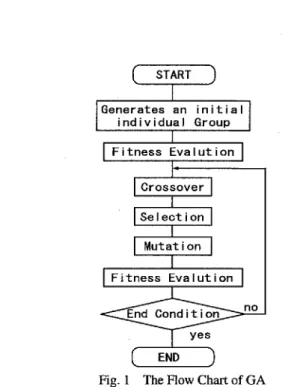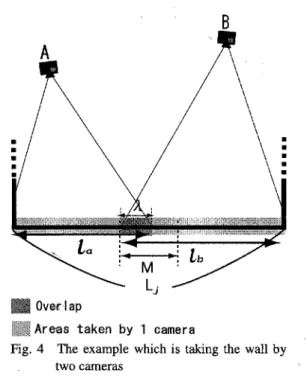Optimization of Discrete Camera Position for Taking All Scenery Inside Buildings by GA
Kunihito YAMAMORIl) Yusuke TOMINARI 2 ) Ikuo YOSHIHARA 3 ) Haruo TAKEDA 4)
ABSTRACT
Minimizing the number of cameras is search for optimal all location for taking all scenery inside buildings. It ·is necessary to take the conditions of a camera and walls into consideration. We proposed a GA-based method to minimize the number of cameras to take images all scenery inside buildings.
We used an actual map, and experimented based on GA. It was able to ask for the number of a camera considered to be close to the minimum as a result.
KeyWords:
Genetic Algorithm
1 Introduction
Recently, Computer Graphics (CG) are used in many fields such as used in movies, games and so on.
Many researchers have been developed new technolo- gies to produce photo-realistic CG images. In particu- lar, movies are using many CG image to synthesize the scenes those are hard to film by human. In the movie field, it is needed the easy way to synthesize the scene in- side !he entire building. For this object, some researchers propose the way to synthesize a continuous image from the multiple photographs take by the multiple viewpoints.
In this case, it is the problem how many photographs (cameras) are needed to synthesize a continuous image, and how to set the camera parameters such as the camera position or camera angle. Of course the movie maker re- quire the way to synthesize a continuous image from the fewest number of photographs.
To synthesize the continuous image, each photograph has to include an appropriate overlap between the pho- tographs. In this research we try to synthesize a contin- uous image from the fewest number of photographs that taken from the optimum camera parameters derived by
l)Professor, Dept. of Computer Sceince and Systems Engineering 2)Undergraduate Student, Dept. of Computer Science and Systems Engineering
3)
Associate Professor, Dept. of Computer Science and Systems En- gineering
4)Director, Vision Technology Center, Systems Development Labo- ratory, Hitachi, Ltd., Dr. of Engineering
Fig. 1 The Flow Chart of GA the genetic algorithm.
This paper is organized as follows; Section 2 intro- duces the genetic algorithm. Section 3 defines the prob- lem that the optimization of the discrete camera position to take pictures inside the building. The optimization method of the camera position is also described. Sec- tion 4 discuss the experimental results through computer simulations. Section 5 concludes this paper.
2 Genetic Algorithm
Genetic Algorithm (GA) is a kind of search algorithm
base on the evolution process in life. .A life has the
genome that describe the features of that life. 1)2)These
genome inherit from their ancestors. In every generation, the genome is modified by the genetic operations such as crossover, mutation and so on. Only the lives with higher flexibility to the environment remain the next generation.
As same as the biological evolution, genetic algorithm modify the artificial genome (individual) by the genetic operations. These individuals encode the candidate of the solution, only the individuals with higher fitness value are remained to the next generation. 3)Fig.?? shows the flowchart of the GA.
3 Definition of the problem
As descIibed in Section 1, we try to make a continu- ous image from the fewest number of photographs taken by the different camera position. This continuous image shows all the scene inside the building. For this objec- tives, we define the problem as following.
• A continuous image synthesized of the multiple photographs represent all scene inside the building.
• The photographs have,overlap to use the reference at the synthesize of the image.
• The camera is only placed on the mesh point to sim- plify the problem.
In usual case the scene inside the building have some furniture such as desk, chair, etc. However, we ignore these objects to simplify the problem. In addition we also ignore the height of the camera position. Therefore the building is expressed by the 2-dimensional floor plan (floor map).
3.1 Discrete camera position
ViltUal mesh is set on the floor map, and the cameras are placed only on the mesh point as shown in Fig.2.
Since the mesh point has the integer address, the data size if a individual becomes small. In addition the pro"
cessing time will become short by the .limitation of the camera position.
3.2 The conditions of photography 3.2.1 Overlap between photographs
To synthesize a continuous photographs in the build- ing, overlaps between images are used as references.
Since the overlap taken by more than two cameras is re- dundant, it is not used to synthesize the continuous im- age. In addition, a photograph is completely included in
-- ~
I--+- -
I~
I- -~-
I- -~-
I- ~--~-
I- ~--~
J I--. -__ --.. --e- -
I I I I_e--e-
I I-_e-
I-.--e
I I--.-
I-.-
I-~
I--.---.-
I I- ..
I- -.-
I- ..
I--.
I""==i;4;::::~ I I • I I I
r- ,,-~---.-- ... - ... --.--.
- -
'-- ..
I- -.I --~-
I - ~-
I -'-
r - ~-
I - ~ --~
I I
~-"--'--~--1 -~--~-~--
I I I I I I..--.
I I--.--,-- ... -- --e--.--e--.--e
I J I I I I I- -.-~--~
I I I·-- - ~--.-
I t..
I--.
:--.
I• The place on which a camera is put
.~
The place on which a camera is not put Fig.2 mass
the other photograph, that is redundant. So these pho- tographs are not used for the reference, too.
If a photograph has a large overlap, it causes more pho- tographs to synthesize a continuous image. Therefore, we give a penalty in the fitness function of GA if a photo- graph includes a large overlap.
The floor map has some thin partition wall. The short side of the partition wall does not consider as the wall.
3.2.2 Camera Conditions
Cameras have various view angle. In this research, The view angle of a camera is 46 degr~e that is. similar to hu- man view angle. The focus range of the camera depends on the kind of camera and the lenses. In this research, the focus range is given by the user. Fig.2 also shows the discrete camera position. In Fig.2 the black dot me~ns the point that can place the camera. The gray dot in Fig.2 means the point that can not place the camera because it is too near to place the camera, or it is in the wall.
3.3 Gene Coding
A camera has three parameters; the horizontal position,
the vertical position and the angle from the horizontal
axis. The set f these' three parameters are aITanged as a
individual as shown in Table 1. In Table 1 Xi and Y i de-
notes the hoIizontal and vertical position of the camera i,
respectively: The Xi and Yi is the integer that mean the
address of the crossing point on the viltual mesh. The 8 i
denotes the angle from the hoIizontal axis of the camera
i. The range of 8i is ± 180 degree from the horizontal axis.
Table. 1 An arrangement of camera parameters in an individual Position of a camera (X coordinates) X(Vo, wo) X(Vl,Wj) ... Xlv", w
ll )
Position of a camera (Y coordinates) Y(Vo, wo) Yevr, wt> ... Yev,,,w
ll )Direction of a camera eo er ... B
Il
3.4 Gene operations 3.4.1 Crossover
@ The ind ividua I group sorted by order with a high evaluation value
High
\ Evalution value
An 'individual is ndomly chosen as a "Parent-B". that ind ividua I including cameras aking the largest
area of the wa I1 An individual is chosen as a
"Parent-A" in order of the high fitness valu . A wall is selected as the "Wor s Wa I I-A" that is taken by the came a in the "Parent-A"
with the sm II est, area.
3. A individual including the camera that takes a pho- tograph including the largest ~ea of the "WorstWall- A" is called as the "BestCamera-B".
2. A provisional individual N is made from the
"Parent-A" . The individual A' is almost the same as the "Parent-A", but some cameras taking the wall that has the smallest area in the photograph are re- moved. The wall taking by the removed cameras is called as the ''WorstWall-A'' in this paper.
1. "Parent-A" is chosen from the individuals in order of high fitness defined by Equation 1 in Section 3.
The number of cameras in a individual are affected by the crossover operation. To reduce. the number of cam- eras, it is desired that a camera takes more area of the walls. For this reason, the crossover is operated as fel- lows;
4. A provisional individual B' is made from the
"Parent-B". The individual B' only includes the
"BestCamera-B". \
77' 884 456 123 543
23 76
Parents-B'
31' 90'
Cameras that takes, the wa I1 X with the largest area.
Parents-B
43 110 1000 40'
Fig. 3 Crossover
~@"
Offspr ing . _,---,
570 87 402 831
570 87 402 831
43 110 1 23
1000 40' 31' W
Cameras" that takes the wa 11 X with the smallest area.
Parents-A 570 87 43 110 lOO' 40'
Parents-A'
(3) (1)
(2) I·(P· + Q-)
f' _ ] ] ]
Jg -


